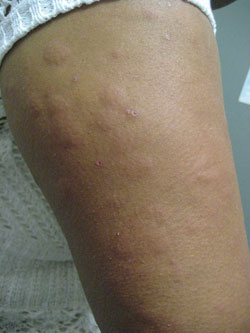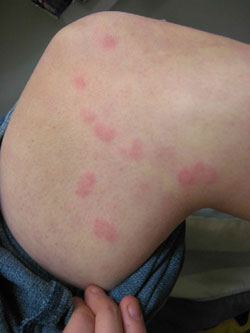The Toronto Dermatology Centre is one of the premiere places in Canada to manage your skin conditions such as hives or urticaria. Our staff of outstanding dermatologists offer both a comprehensive assessment and diagnosis of your skin, and also discuss all the treatment options.
 Urticaria (hives) are localized, pale, itchy, pink wheals (swellings) that can burn or sting. They may occur singularly or in groups on any part of the skin; they are part of an allergic reaction and are very common. Approximately 15% of the population will have at least one episode in their lifetime. Most episodes of hives disappear quickly in a few days to a few weeks. Occasionally, a person will have them for many months or years. New hives may develop as old ones fade. Hives can vary in size from as small as a pencil eraser to as large as a dinner plate, and may join to form even larger swellings.
Urticaria (hives) are localized, pale, itchy, pink wheals (swellings) that can burn or sting. They may occur singularly or in groups on any part of the skin; they are part of an allergic reaction and are very common. Approximately 15% of the population will have at least one episode in their lifetime. Most episodes of hives disappear quickly in a few days to a few weeks. Occasionally, a person will have them for many months or years. New hives may develop as old ones fade. Hives can vary in size from as small as a pencil eraser to as large as a dinner plate, and may join to form even larger swellings.
Hives are produced by blood plasma leaking through tiny gaps between the cells lining small blood vessels in the skin. Histamine is a chemical released from cells in the skin called “mast cells” which lie along blood vessels. Allergic reactions, chemicals in foods, or medications may cause hives; sometimes it is impossible to find out the cause. When hives form around the eyes, lips, or genitals, the tissue may swell excessively. Although frightening, the swelling usually goes away in less than 24 hours. Severe cases of hives may cause difficulty in breathing or swallowing and emergency room care is required.
Acute Urticaria
Acute urticaria lasts less than six weeks. An underlying cause can be frequently identified and eliminated. The most common causes for acute urticaria are: foods, drugs, or infections. Insect bites, internal diseases, pressure, cold, or sunlight also may be responsible.
Foods
The most common foods that cause urticaria are: nuts, chocolate, shellfish, tomatoes, eggs, berries, and milk. Fresh foods cause hives more often than cooked foods. Food additives and preservatives may also cause hives. Hives may appear within minutes to several hours after eating.
Drugs
Almost any medication, prescription or over-the-counter, can cause hives. Antibiotics, pain medications, sedatives, tranquilizers, diuretics (water pills), diet supplements, antacids, arthritis medication, vitamins, herbal supplements, eye and eardrops, laxatives, vaginal douches, or any other non-prescription item can be a potential cause of urticaria. It is important to inform the dermatologist of ALL prescription and over-the-counter medications being used to help find the cause of the hives.
Infections
Many infections can cause urticaria. Viral upper-respiratory tract infections (colds) are a common cause in children. Other viruses, including hepatitis and a number of bacterial and fungal infections, may cause urticaria.
 Chronic Urticaria
Chronic Urticaria
Chronic urticaria lasts more than six weeks. The cause of chronic urticaria is more difficult to identify and is found only in a small percentage of patients. The dermatologist reviews a patient’s medical history, asks questions, and conducts a physical examination. Testing, such as blood work or a biopsy may be necessary.
Some feel that patient with chronic urticaria may be sensitive to salicylates. Salicylates are the active ingredient in aspirin and are found in all plant matter to some extent (fruits, veggies, herbal supplements, etc). If you find that taking aspirin makes your hives worse, you may have discovered your cause. This is also true if you cannot tolerate other non-steroidal anti-inflammatory drugs (NSAIDs), such as Ibuprofen since they are cross-reactive with salicylates.
The foods most commonly reported to induce urticaria are: shellfish, fish, egg, nuts, chocolate, berries, tomatoes, cheese, milk, and wheat.
Foods reported to release histamine directly from mast cells are: uncooked egg whites, shellfish, strawberries, tomatoes, fish, chocolate, pineapple and alcohol.
Foods reported to be high in histamine are: fermented cheeses (e.g. Camembert, Brie, Gruyere, Cheddar, Roquefort, Parmesan), brewer’s yeast, shellfish, many fin fish, canned fish, tomato, spinach, red wine (especially Chianti), beer, unpasteurized milk (e.g., cow, goat or human milk), chicken, dry pork sausage, beef sausage, ham, chocolate, fermented soy products, and all fermented vegetables, such as sauerkraut.
Physical Urticarias
Physical urticaria may be caused by sunlight, heat, cold, water, pressure, vibration, or exercise. Solar urticaria forms within minutes of sun exposure and typically fades within one to two hours. Cold urticaria appears when the skin is warmed after exposure to cold. Urticaria, which forms in response to the cold or the water when swimming, for example, can produce wheezing, flushing, generalized hives, and fainting.
Dermatographic Urticaria (Dermatographism)
Dermatographic urticaria forms after firmly stroking or scratching the skin, and can often occur with other forms of urticaria. It affects 5% of the population. Most people with this condition are otherwise healthy. Dermatographism may last for months or even years.
Treatment
The best urticaria treatment is to find and eliminate the cause whenever possible. Antihistamines are prescribed to provide relief and work best if taken on a regular schedule to prevent hives from forming. There are many antihistamines available. No one antihistamine works for everyone. The dermatologist may use combinations to control the urticaria. In severe cases, an injection of epinephrine (adrenalin) may be needed. Oral steroids (e.g. prednisone) may also bring dramatic relief, but its use must be limited to short periods of time. Less commonly, other systemic medications such as Cyclosporine, Methotrexate or Cellcept are used.
